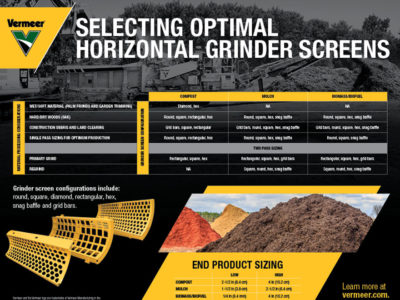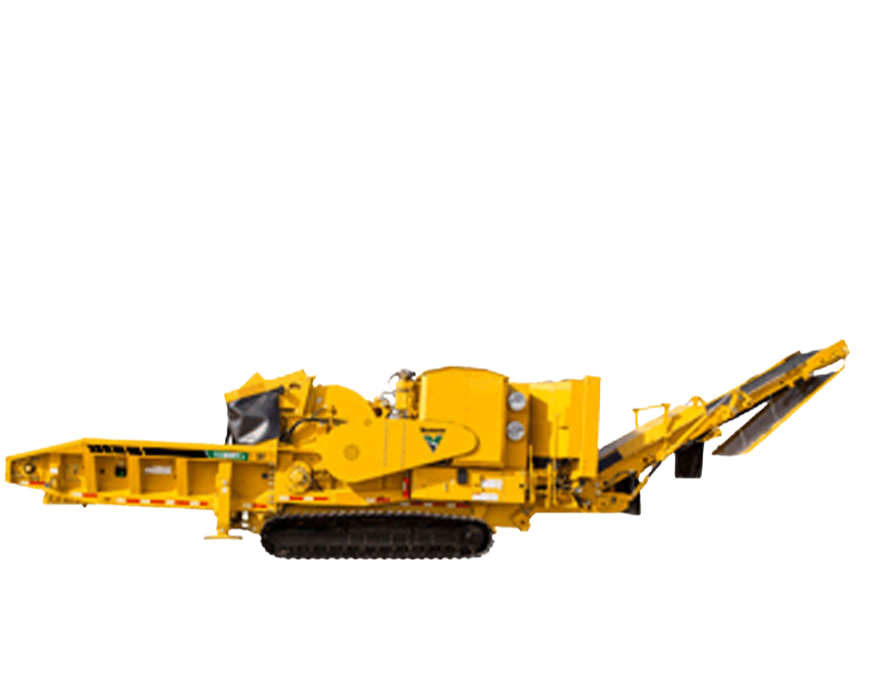Hole shape and size impact grinding efficiency and quality of the end product
Horizontal grinder screen hole patterns come in dozens of shapes and sizes, so it’s no wonder it can be a real challenge to decide which screens you should be using. There are several factors to consider when selecting an optimal horizontal grinder screen. The two most important ones are the type of incoming material processing and the end product being produced. The moisture content of the material being processed and its density (hardness) are the key factors to consider when selecting the shape of a screen’s hole pattern. In contrast, the desired end-product size and consistency are essential when choosing dimensions of a screen’s pattern. The combination of the screen’s hole opening shape and size helps determine how quickly the material can be processed by the grinder and the quality/consistency of the material coming off the conveyor.
According to Jeff Bradley, product manager for Vermeer Environmental Solutions, around 95% of organic recycled material being produced today is sold as compost, mulch and biomass/biofuel. “Each of these three different markets has different requirements for end-product sizing,” Bradley explained. “The consistency of material sizing can have a huge impact on the price a customer is willing to pay for something, especially when it comes to mulch. Many mulch manufacturers demand a consistent size and shape. Too many fines or chunky oversized material mixed into the mulch will drive down the price someone is willing to pay for it. However, product consistency requires more processing time. So, there are tradeoffs for grinding operations, and finding the right balance is what they should all be striving for.”
Grinder screen hole shape
Optimizing horizontal grinder screen configurations start with evaluating the type of incoming material and should be reevaluated when material or weather patterns change. “Grinding softer, wet material, like palm fronds or garden trimmings, has a different set of challenges than harder woods, like oak,” said Bradley. “In softer, wet material, a diamond screen works well because it creates a pitch point that can help cut the loose material. For hard, dry woods, the screens don’t play as much of a role in cutting material — only sizing. So, too much of an edge can lead to having more fines coming off the conveyor.”
Square and round holes are the two most common shapes used on grinders, but there are many other patterns to choose from. Here are a few options to consider.
- Square screen: The most commonly used screen type for horizontal grinders, square holes work well in most woody materials. Square screens produce consistent material sizes, but a larger hole opening can result in varying material lengths, and regrinding or screening may be required for an optimal end product sizing.
- Round screen: Commonly used on tub grinders, round-hole screens are an ideal option for working in soft to hardwoods with normal moisture levels. Round screens are more commonly used with tub grinders because they are efficient at creating consistent end product sizes.
- Diamond screen: This screen is ideal for wet, difficult to grind material like compost, palm fronds, damp grass and leaves. These materials can build up on the horizontal planes of square-and round-hole screens, leading to more recirculation of material and reducing productivity. A diamond screen channels material to the point so the cutter can pinch or cut the material off and help remove material that would otherwise accumulate.
- Rectangular screen: This screen allows more material to pass through compared to square- and round-hole configurations. Rectangular screens are a good overall primary grind screen. But, product consistency may suffer, so grinding and/or screening may be required.
- Hex screen: This is an alternative for round screens for processing material faster since the hole design allows for more openings in the same amount of square footage (meters). The hex screen has similar production rates as square screens in many types of materials.
- Snag baffle screen: A snag baffle is an option for achieving the consistent end products. It’s essentially a hook on the back of the screen that snags material of the wrong specification and holds it until the knives come around again to cut the wood down to the desired size. This option provides fast processing while maintaining a consistent end product size when size requirements are the most important factor.
- Grid bars: Welded horizontally across the screen face, grid bars function as a secondary anvil and are useful in a primary grind for processing construction debris or land clearing applications where there is less concern about the end-product specifications.
Grinder screen hole sizing
While the hole shape of the screen you use on the horizontal grinder has more to do with the type of incoming material being processed, the screen size is related to the end product sizing. Here is a brief overview for material sizing considerations focusing on the three big markets: compost, mulch and biomass.
- Compost: For most composting facilities, the ideal sizing is material under 4 inches (10.2 cm) in length and width. Bradley said that anything larger than 4 inches (10.2 cm) might not break down as efficiently and impact the health of the windrow’s microbiology. “Also, compost windrows with larger material will cause more wear on compost turners when turning and can result in a higher overs content in the finished compost,” he explained.
Bradley also recommended using a smaller screen size than what you think you need if you’re using a square or rectangular screen. “If a grinder operator wants 4 inches (10.2 cm) to be the maximum size and they are running square or rectangular screens, it’s a good idea to use a screen with 3-inch x 3-inch (7.6-cm x 7.6-cm) or 3.5-inch (8.9 cm) square hole sizes depending on material. There is a bit less sizing consistency with this grinder screen configuration than with some of the other hole patterns.”
- Mulch: The sweet spot for most of the mulch market is 2-1/2 inches (6.4 cm). However, there is a mulch market down to 1-1/2 inches (3.81 cm). “For mulch, having a consistent size can mean the difference between product sitting or flying off the yard,” said Bradley. “Not only do grinder operators have to make sure the material coming off the grinder’s discharge conveyor isn’t too big, but they also have to watch the amount of fines too. Too many fines may require additional screening, which can eat away at a producer’s margins.”
Using a snag baffle screen is a great way to achieve sizing consistency for the mulch market. However, using this type of screen with smaller holes works best if you pre-grind the material first.
According to Bradley, many mulch producers prefer to do an initial grind of raw material using a grinder screen with larger openings, then regrind it right before selling the mulch. “The spring and fall are when the bulk of mulch is sold, and today more than 70% of mulch sold is colored. So, by having a stockpile of semi-processed material ready to regrind, mulch producers can cut down on their processing time during the busiest season and colorize the mulch right before it’s sold to maximize how long the color will last.”
- Biomass/biofuel: Most of the biomass market is looking for a chip product to burn. Accomplishing this requires a chip drum and the right screens. Vermeer offers an optional chip drum for the woody biofuel market to produce a chip product. From there, you need to choose the appropriate square or rectangle screen to produce the desired chip size. The burner type, conveyor used to feed the burner and storage arrangement drive this market’s chip sizing. Industrial burners typically are designed to handle larger biomass material sizes, while residential burners require smaller sizes.
Bradley also said there is a growing market to sell biomass material for wood pellet production. “Producing wood pellets requires extra processing by the company making the pellets, but their facilities are generally set up to work with chips in the ¼-inch (6.4 mm) range. Chip consistency and fiber length are paramount for this market.”
Mixing grinder screen sizes
Bradley also suggested that horizontal grinder owners experiment with their setup by running two different size screens on their Vermeer horizontal grinder. “For many types of wood, an operator can help improve output by running a smaller grinder screen on the bottom and larger screen on top, without much of an impact to product consistency,” he said. “The majority of product sizing is done by the first screen, so the second can be a little bigger to help purge material quickly and reduce the amount of fines since the material isn’t recirculating around the mill as much. This approach can help reduce wear and maximize productivity.”
There are dozens of different grinder screen configurations on the market for horizontal grinders. If you need help selecting the optimal horizontal grinder screens for your operation, contact your local Vermeer dealer. For more information about Vermeer horizontal grinders and recycling equipment, visit vermeer.com.
Vermeer Corporation reserves the right to make changes in product engineering, design and specifications; add improvements; or discontinue manufacturing or distribution at any time without notice or obligation. Equipment shown is for illustrative purposes only and may display optional accessories or components specific to their global region. Please contact your local Vermeer dealer for more information on machine specifications.
Vermeer and the Vermeer logo are trademarks of Vermeer Manufacturing Company in the U.S. and/or other countries.
© 2021 Vermeer Corporation. All Rights Reserved.

